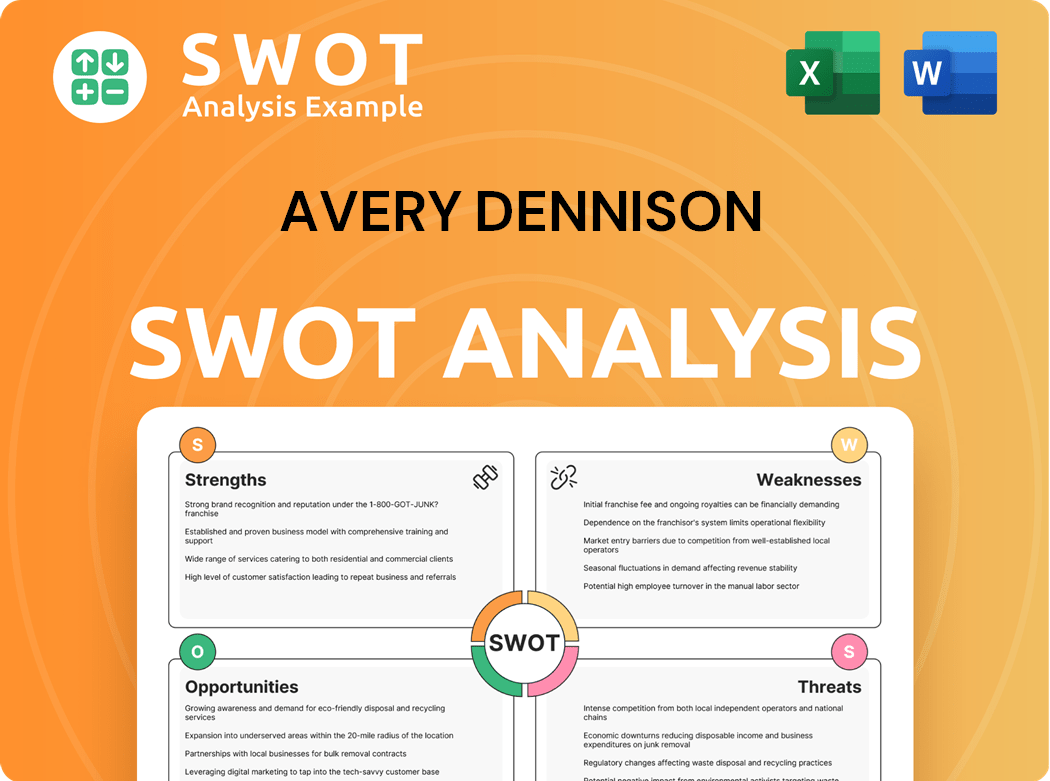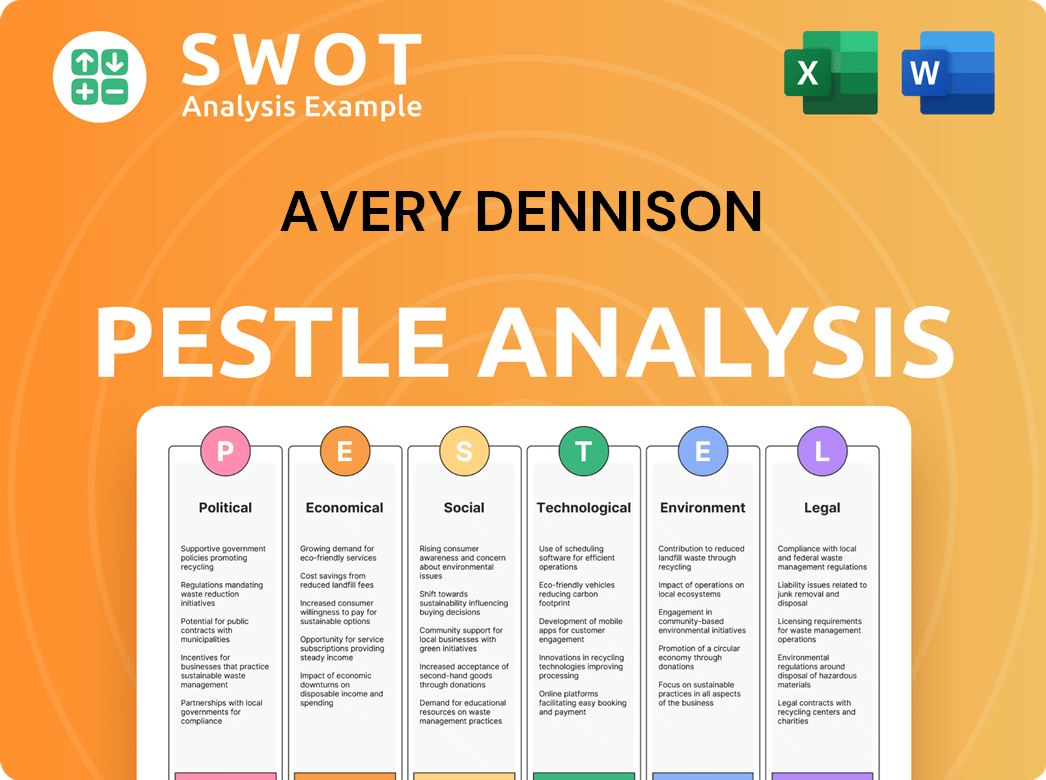Avery Dennison Bundle
Who Truly Controls Avery Dennison?
Understanding Avery Dennison SWOT Analysis is crucial, but have you ever wondered who pulls the strings of this global materials science giant? From its humble beginnings in 1935 to its current status as a Fortune 500 company, the story of Avery Dennison is intertwined with the evolution of its ownership. Knowing who owns Avery Dennison is key to understanding its strategic direction and future prospects.

This exploration into Avery Dennison ownership will uncover the key players shaping its destiny. We'll examine the company's history, from its founding as Kum Kleen Products to its present-day structure, including its public shareholder base. Discover the influence of major shareholders and how the company's ownership has evolved, impacting its financial performance and market position. Learn about Avery Dennison's company structure and the answers to questions like "Who is the CEO of Avery Dennison?" and "Is Avery Dennison a public company?".
Who Founded Avery Dennison?
The story of Avery Dennison ownership begins in 1935. R. Stanton Avery started Kum Kleen Products in Los Angeles, California, with a modest $100 loan. This marked the inception of what would become a global leader in materials science and manufacturing.
Originally named Kum Kleen Products to highlight the removability of its self-adhesive labels, the company underwent several name changes. These changes reflect its growth and evolution over the years, eventually leading to the current Avery Dennison company.
The company's journey included significant milestones, such as the 1990 merger with Dennison Manufacturing Company. This merger was a pivotal moment in the history of Avery Dennison, shaping its current structure and market position.
R. Stanton Avery founded Kum Kleen Products in 1935.
The company started with a $100 loan.
The original name was Kum Kleen Products.
Changed to Avery Adhesives.
Incorporated as Avery Adhesive Label Corp.
Merged with Dennison Manufacturing Company.
The Dennison Manufacturing Company, which merged with Avery, had its own rich history. Founded in 1844 by Andrew Dennison and his son Aaron Lufkin Dennison, it initially focused on jewelry and watch boxes. Aaron later passed the company to his brother, Eliphalet Whorf Dennison, who developed it into a significant industrial enterprise. Specific details about the equity split or shareholding percentages of the founders and early backers at the company's beginning are not available in public records. For more insights into the company's structure and operations, you can explore further details in the article about Avery Dennison.
Avery Dennison SWOT Analysis
- Complete SWOT Breakdown
- Fully Customizable
- Editable in Excel & Word
- Professional Formatting
- Investor-Ready Format

How Has Avery Dennison’s Ownership Changed Over Time?
The ownership of Avery Dennison, a publicly traded entity, is primarily characterized by a diverse structure. Since its listing on the New York Stock Exchange (NYSE: AVY), the company has evolved from a privately held entity to one with widespread ownership. This transition reflects a shift from concentrated control to a model where institutional investors, mutual funds, and individual investors collectively shape the company's direction. Understanding the Marketing Strategy of Avery Dennison is crucial to understanding its current market position.
The evolution of Avery Dennison's ownership structure has been marked by key events, including its initial public offering (IPO) and subsequent stock offerings. These events broadened the shareholder base and attracted institutional investors. The company's history includes strategic acquisitions and divestitures, which have influenced its financial performance and, consequently, its stock value. The company's reported sales in 2024 were $8.8 billion.
| Ownership Category | Approximate Percentage | Key Holders |
|---|---|---|
| Institutional Investors | Approximately 83.14% | Vanguard (11.80%), Vanguard Index Funds (9.91%), iShares (5.08%), SPDR (3.87%), T. Rowe Price, Invesco, Columbia Funds |
| Insiders | Approximately 0.73% | Company executives and board members |
| Public Companies and Individual Investors | Approximately 16.13% | Various |
Institutional investors, such as Vanguard, Vanguard Index Funds, iShares, and SPDR, collectively hold the largest portion of Avery Dennison's stock. These entities significantly influence the company's strategic decisions. Insiders, including executives and board members, hold a smaller percentage, while public companies and individual investors make up the remaining ownership. Avery Dennison's financial performance, including its annual sales, is detailed in its SEC filings, offering insights into its operations and ownership structure. The company's market capitalization reflects its overall value, influenced by its stock price and the number of outstanding shares.
Avery Dennison is a publicly traded company, primarily owned by institutional investors.
- Institutional investors hold the majority of shares.
- Insiders own a small percentage of the stock.
- Public and individual investors also have a stake.
- The company's ownership structure influences its strategic decisions.
Avery Dennison PESTLE Analysis
- Covers All 6 PESTLE Categories
- No Research Needed – Save Hours of Work
- Built by Experts, Trusted by Consultants
- Instant Download, Ready to Use
- 100% Editable, Fully Customizable

Who Sits on Avery Dennison’s Board?
The current board of directors at Avery Dennison plays a vital role in guiding the company. As of March 2024, the board consisted of 10 nominated directors. These directors serve for a one-year term, ensuring a regular cycle of review and renewal within the company's leadership structure. Stockholders of record as of February 26, 2024, were eligible to vote in the annual meeting.
Shareholders have multiple ways to cast their votes, including online, by telephone, by mail, or, in certain instances, during the virtual annual meeting. This flexibility ensures broad participation from the shareholder base. The company's governance structure is also designed to protect the interests of its shareholders, with provisions for indemnifying directors and officers.
| Director | Title | Term |
|---|---|---|
| Mitch Butier | Chairman of the Board | One-year term ending at the 2026 Annual Meeting |
| Mr. Siewert | Lead Independent Director | One-year term, subject to re-election |
| Board Members | Nominated Directors | One-year term |
The voting structure for Avery Dennison's common stock is generally one-share-one-vote, giving each holder one vote per share on all matters presented. The board can issue preferred stock, which could have special rights and voting powers, although no preferred stock was outstanding as of September 30, 2010. In February 2025, Mitch Butier was re-elected as Chairman of the Board, and Mr. Siewert was elected as Lead Independent Director. This leadership structure reflects the company's commitment to good governance, even as it adapts to changes like the CEO transition. This is important for anyone looking to understand the Target Market of Avery Dennison.
Avery Dennison's board consists of 10 directors, with shareholders voting on key matters. The company uses a one-share-one-vote system. Recent elections re-confirmed key leadership positions.
- The board's structure ensures regular review and renewal.
- Shareholders have multiple voting options, promoting broad participation.
- The company's governance structure includes provisions to protect shareholder interests.
- Recent leadership elections show commitment to good governance.
Avery Dennison Business Model Canvas
- Complete 9-Block Business Model Canvas
- Effortlessly Communicate Your Business Strategy
- Investor-Ready BMC Format
- 100% Editable and Customizable
- Clear and Structured Layout

What Recent Changes Have Shaped Avery Dennison’s Ownership Landscape?
In recent years, the focus on returning value to shareholders has been evident in the financial strategies of the company. In 2024, the company allocated $525 million in cash to shareholders through dividends and share repurchases. The company repurchased 1.2 million shares at a cost of $248 million. For the fourth quarter of 2024, the company returned $210 million to shareholders, buying back 0.7 million shares at a cost of $140 million. As of March 31, 2025, the company's quarterly stock buybacks amounted to $261.60 million, with a 6-month share buyback ratio of 2.35% as of March 2025. The company's board authorized a new stock repurchase program of up to $750 million in April 2025. Furthermore, the quarterly dividend increased by approximately 7% to $0.94 per share, payable on June 18, 2025.
Leadership changes have also played a role in shaping the company's direction. Deon Stander became President and CEO on September 1, 2023, succeeding Mitch Butier. In November 2024, Gregory S. Lovins, the Senior Vice President and Chief Financial Officer, went on medical leave, and Danny G. Allouche was appointed as the Senior Vice President and Interim Chief Financial Officer. In April 2025, Anil Sharma was named Senior Vice President and General Manager for Materials Group, North America.
| Metric | Value | Year |
|---|---|---|
| Share Repurchases | $248 million | 2024 |
| Dividend Increase | 7% | 2025 |
| New Share Repurchase Program | Up to $750 million | April 2025 |
The company's ownership structure reflects a trend towards increased institutional ownership. The company's strategic moves include investments and acquisitions, such as joining Wiliot's investor group in 2019 and acquiring Smartrac's RFID transponder business in 2020. In 2021, the company launched atma.io, a 'digital product cloud.' Recent acquisitions include TexTrace in February 2022 and Catchpoint Ltd.'s linerless label technology in March 2022. To understand more about the business, consider reviewing the Revenue Streams & Business Model of Avery Dennison.
The company anticipates reported earnings per share for 2025 to be in the range of $9.55 to $9.95, with adjusted EPS guidance of $9.80 to $10.20. These figures reflect the company's expectations for the coming year.
The company continues to prioritize disciplined capital allocation and growth in high-value categories. This strategic approach aims to enhance long-term value creation.
The company's dedication to returning value to shareholders is demonstrated through share buybacks and dividend increases. This commitment is a key aspect of its financial strategy.
Leadership changes, including the appointment of Deon Stander as CEO, have shaped the company's direction. These transitions impact strategic decisions.
Avery Dennison Porter's Five Forces Analysis
- Covers All 5 Competitive Forces in Detail
- Structured for Consultants, Students, and Founders
- 100% Editable in Microsoft Word & Excel
- Instant Digital Download – Use Immediately
- Compatible with Mac & PC – Fully Unlocked

Related Blogs
- What are Mission Vision & Core Values of Avery Dennison Company?
- What is Competitive Landscape of Avery Dennison Company?
- What is Growth Strategy and Future Prospects of Avery Dennison Company?
- How Does Avery Dennison Company Work?
- What is Sales and Marketing Strategy of Avery Dennison Company?
- What is Brief History of Avery Dennison Company?
- What is Customer Demographics and Target Market of Avery Dennison Company?
Disclaimer
All information, articles, and product details provided on this website are for general informational and educational purposes only. We do not claim any ownership over, nor do we intend to infringe upon, any trademarks, copyrights, logos, brand names, or other intellectual property mentioned or depicted on this site. Such intellectual property remains the property of its respective owners, and any references here are made solely for identification or informational purposes, without implying any affiliation, endorsement, or partnership.
We make no representations or warranties, express or implied, regarding the accuracy, completeness, or suitability of any content or products presented. Nothing on this website should be construed as legal, tax, investment, financial, medical, or other professional advice. In addition, no part of this site—including articles or product references—constitutes a solicitation, recommendation, endorsement, advertisement, or offer to buy or sell any securities, franchises, or other financial instruments, particularly in jurisdictions where such activity would be unlawful.
All content is of a general nature and may not address the specific circumstances of any individual or entity. It is not a substitute for professional advice or services. Any actions you take based on the information provided here are strictly at your own risk. You accept full responsibility for any decisions or outcomes arising from your use of this website and agree to release us from any liability in connection with your use of, or reliance upon, the content or products found herein.